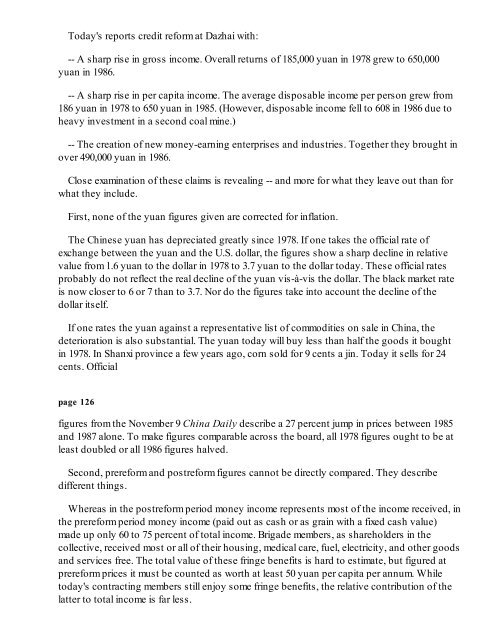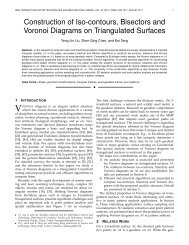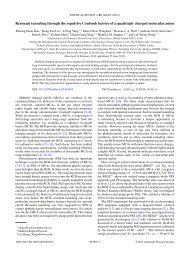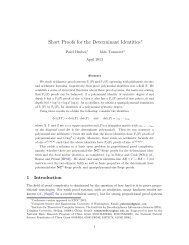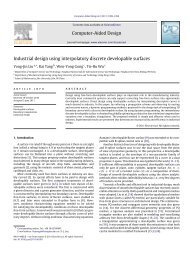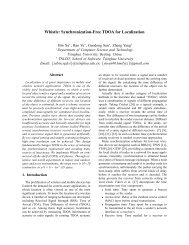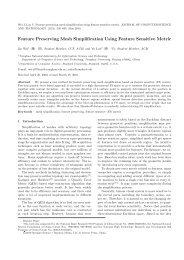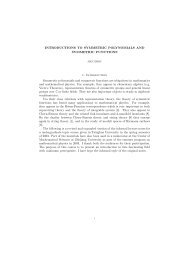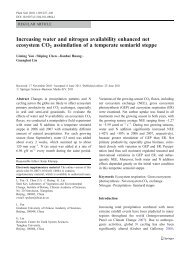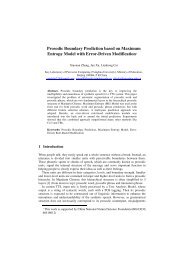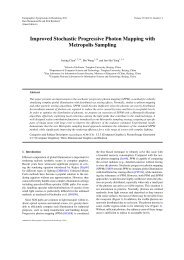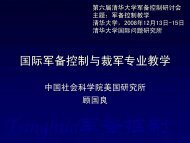Today's reports credit reform at Dazhai with:-- A sharp rise in gross income. Overall returns <strong>of</strong> 185,000 yuan in <strong>1978</strong> grew to 650,000yuan in 1986.-- A sharp rise in per capita income. <strong>The</strong> average disposable income per person grew from186 yuan in <strong>1978</strong> to 650 yuan in 1985. (However, disposable income fell to 608 in 1986 due toheavy investment in a second coal mine.)-- <strong>The</strong> creation <strong>of</strong> new money-earning enterprises and industries. Together they brought inover 490,000 yuan in 1986.Close examination <strong>of</strong> these claims is revealing -- and more for what they leave out than forwhat they include.First, none <strong>of</strong> the yuan figures given are corrected for inflation.<strong>The</strong> Chinese yuan has depreciated greatly since <strong>1978</strong>. If one takes the <strong>of</strong>ficial rate <strong>of</strong>exchange between the yuan and the U.S. dollar, the figures show a sharp decline in relativevalue from 1.6 yuan to the dollar in <strong>1978</strong> to 3.7 yuan to the dollar today. <strong>The</strong>se <strong>of</strong>ficial ratesprobably do not reflect the real decline <strong>of</strong> the yuan vis-à-vis the dollar. <strong>The</strong> black market rateis now closer to 6 or 7 than to 3.7. Nor do the figures take into account the decline <strong>of</strong> thedollar itself.If one rates the yuan against a representative list <strong>of</strong> commodities on sale in <strong>China</strong>, thedeterioration is also substantial. <strong>The</strong> yuan today will buy less than half the goods it boughtin <strong>1978</strong>. In Shanxi province a few years ago, corn sold for 9 cents a jin. Today it sells for 24cents. Officialpage 126figures from the November 9 <strong>China</strong> Daily describe a 27 percent jump in prices between 1985and 1987 alone. To make figures comparable across the board, all <strong>1978</strong> figures ought to be atleast doubled or all 1986 figures halved.Second, prereform and postreform figures cannot be directly compared. <strong>The</strong>y describedifferent things.Whereas in the postreform period money income represents most <strong>of</strong> the income received, inthe prereform period money income (paid out as cash or as grain with a fixed cash value)made up only 60 to 75 percent <strong>of</strong> total income. Brigade members, as shareholders in thecollective, received most or all <strong>of</strong> their housing, medical care, fuel, electricity, and other goodsand services free. <strong>The</strong> total value <strong>of</strong> these fringe benefits is hard to estimate, but figured atprereform prices it must be counted as worth at least 50 yuan per capita per annum. Whiletoday's contracting members still enjoy some fringe benefits, the relative contribution <strong>of</strong> thelatter to total income is far less.
In assessing prereform incomes, furthermore, one must take into account the value <strong>of</strong> thenewly created liquid assets added annually to the accumulation fund and the value <strong>of</strong> thefixed assets created by joint labor in capital construction, which occupied the labor force formany months every year. <strong>The</strong>se assets were mainly high-yield, terraced fields and solid,calamity-pro<strong>of</strong> stone caves for family homes. <strong>The</strong> fields brought no immediate return butensured a higher level <strong>of</strong> earned income in the future. While it is difficult to give a monetaryvalue to such assets, from the labor expended per mu and from the cash value per mu <strong>of</strong> fertilecrop land and the cash value <strong>of</strong> cave homes, one can estimate that they were worth at least anadditional 50 yuan per capita per annum.To make a valid comparison one would have to add all these figures together: 186 + 50 + 50= 286, then double the sum to correct for inflation. <strong>The</strong> answer, 572, approaches the currentper capita figure <strong>of</strong> 650.[1]To be fair, the increased collective assets <strong>of</strong> present-day Dazhai should also be figured intothe current per capita income figures. <strong>The</strong>y would surely raise them by a significant amount.<strong>The</strong> figures, however, would not rise as high as one might expect because in the past winter1. Many peasants <strong>of</strong> course prefer cash in hand and the possibility <strong>of</strong> television sets tape recorders, andwashing machines to increased fixed assets in land or houses Nevertheless these assets cannot be ignored.page 127labor done for workpoints created the new assets. Today all community work such as fixingroads, repairing terraces, building new fields, extending irrigation, and adding new enterprisesmust be paid for with money wages.Workpoints entitle a participant only to a proportionate share <strong>of</strong> that part <strong>of</strong> communityincome that is set aside for distribution as individual earnings. <strong>The</strong> more workpoints the laborforce as a whole expends on capital construction, the less each point is worth because thework yields no income in the current year. By working on capital construction all winter anindividual peasant can increase his or her share <strong>of</strong> the total fund distributed, as compared tothe share <strong>of</strong> someone who does not join the work. But the work done will not increase theoverall size <strong>of</strong> the fund, for that is determined by the value <strong>of</strong> the crops harvested and also bythe income <strong>of</strong> sideline enterprises minus production expenses and funds set aside for welfareand for future expenses and investments. <strong>The</strong>se latter two categories usually are combined inan accumulation fund.Money wages, on the other hand, must be paid out <strong>of</strong> the accumulation fund, thustransferring wealth from the community to the individual. As the value <strong>of</strong> the fixed assetsgoes up, the liquid assets held in the accumulation fund go down. Furthermore, the wagesearned should already be figured into the per capita income figure. None <strong>of</strong> this was true inthe past.In the past, also, all production expenses were clearly defined and accounted for. <strong>The</strong>y
- Page 1 and 2:
THE GREATREVERSALThe Privatization
- Page 3 and 4:
This essence was known to many in C
- Page 5 and 6:
Introduction:China'sRuralReformsThe
- Page 7 and 8:
concern was, of course, the country
- Page 9 and 10:
I looked down in growing disbelief
- Page 11 and 12:
edefining what the word meant. Cert
- Page 13 and 14:
themselves, communists had, perforc
- Page 16 and 17:
It is against the background of Chi
- Page 18 and 19:
eformers. Throughout the whole cour
- Page 20 and 21:
in China. It emphasizes above all t
- Page 22 and 23:
Is Red," that solemn hymn to Mao Ze
- Page 24 and 25:
Hard work to transform the land was
- Page 26 and 27:
If meeting nonrelated young people
- Page 28 and 29:
and three times elevated to top pos
- Page 30:
can supply the raw material for lin
- Page 34 and 35:
Construction Bureau who wanted to n
- Page 36 and 37:
had already found wives and several
- Page 38 and 39:
the peasants first gave support to
- Page 40 and 41:
Zhanglaozhuang brigade, Ershihying
- Page 42 and 43:
see Gaojen commune. There 7,300 abl
- Page 44 and 45:
in 1978), (3) they planted large ar
- Page 46 and 47:
can do so will others not denounce
- Page 48 and 49: destroyed all economies of scale an
- Page 50 and 51: The rejection of the above proposit
- Page 52 and 53: and was raising two pigs that she e
- Page 54 and 55: page 71in some of the new industrie
- Page 56 and 57: page 74Reformin Stride:Rural Change
- Page 58 and 59: authorities is that it automaticall
- Page 60 and 61: most promising things in the collec
- Page 62 and 63: than it contributes itself, it is a
- Page 64 and 65: mechanization plan could have done
- Page 66 and 67: page 86units, taking a mature sheep
- Page 68 and 69: measures are necessary.Since these
- Page 70 and 71: tremely hard to carry out. Most mea
- Page 72 and 73: 60,000 mou. This would make seasona
- Page 74 and 75: lock the gates at Qinghua and other
- Page 76 and 77: programs that discourage production
- Page 78 and 79: 19781979198019811982198319841985467
- Page 80 and 81: Peasants who opt for transport on t
- Page 82 and 83: policy. Yet they are much touted by
- Page 84 and 85: millions of mu of badly eroded slop
- Page 86 and 87: page 111culture must also be modern
- Page 88 and 89: The Problem of UnemploymentThe most
- Page 90 and 91: mechanization of the more advanced
- Page 92 and 93: tractor and/or implement tire that
- Page 94 and 95: difficult form of cooperation. Betw
- Page 96 and 97: In order to mechanize agriculture s
- Page 100 and 101: were deducted from net income befor
- Page 102 and 103: trees that appear to be, if not aba
- Page 104 and 105: denounced by the central government
- Page 106 and 107: spirit of Dazhai's citizens and to
- Page 108 and 109: Ironic Lessons, Past and PresentIn
- Page 110 and 111: Mao'sRuralPoliciesRevisitedA questi
- Page 112 and 113: point frequently raised by the refo
- Page 114 and 115: page 145Furthermore, the state help
- Page 116 and 117: mechanisms rather than government d
- Page 118 and 119: tractors who leased collective ente
- Page 120 and 121: All this alarmed certain forces in
- Page 122 and 123: terthrusts over the years. All of t
- Page 124 and 125: exercises." Just as happened during
- Page 126 and 127: every region.In the fourth place, b
- Page 128 and 129: preserve a strong collective core.
- Page 130 and 131: Finally, China's independent nation
- Page 132 and 133: The World Bank strategy of opening
- Page 134 and 135: people. They want to transform the
- Page 136 and 137: The reformers hoped and planned tha
- Page 138 and 139: TiananmenMassacre:June 1989It's imp
- Page 140 and 141: left, and then there would be a new
- Page 142 and 143: the beginning of it. Once the army
- Page 144 and 145: and I asked him why on earth he wen
- Page 146 and 147: have been doing this work for many
- Page 148 and 149:
going to sweep everybody out, so th
- Page 150 and 151:
affront, as turmoil, as chaos, and


